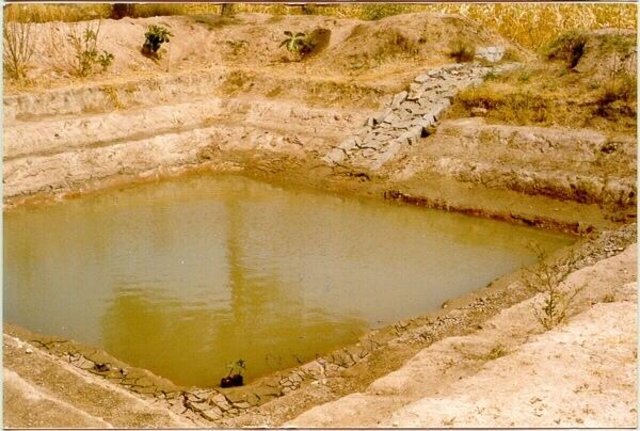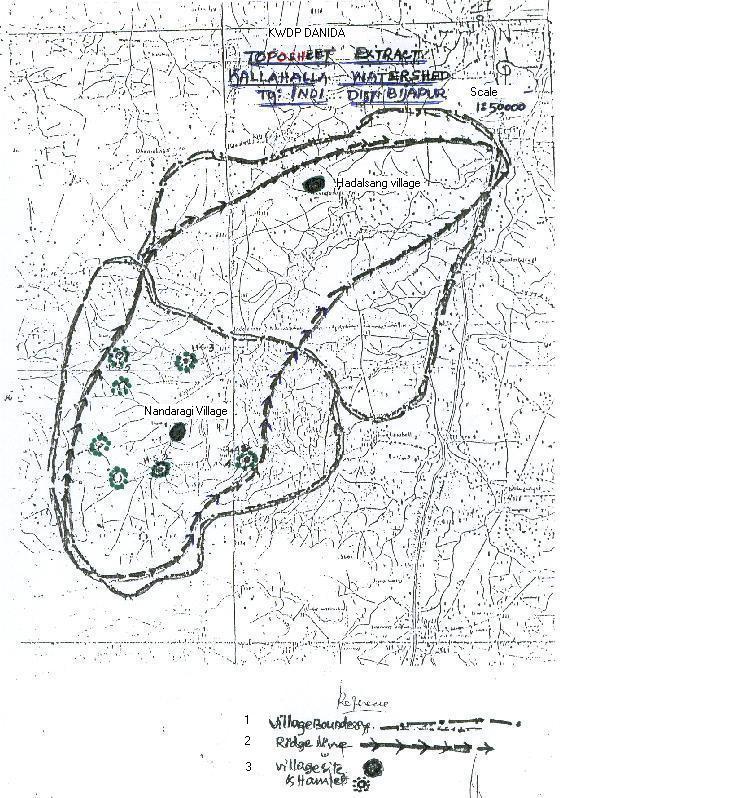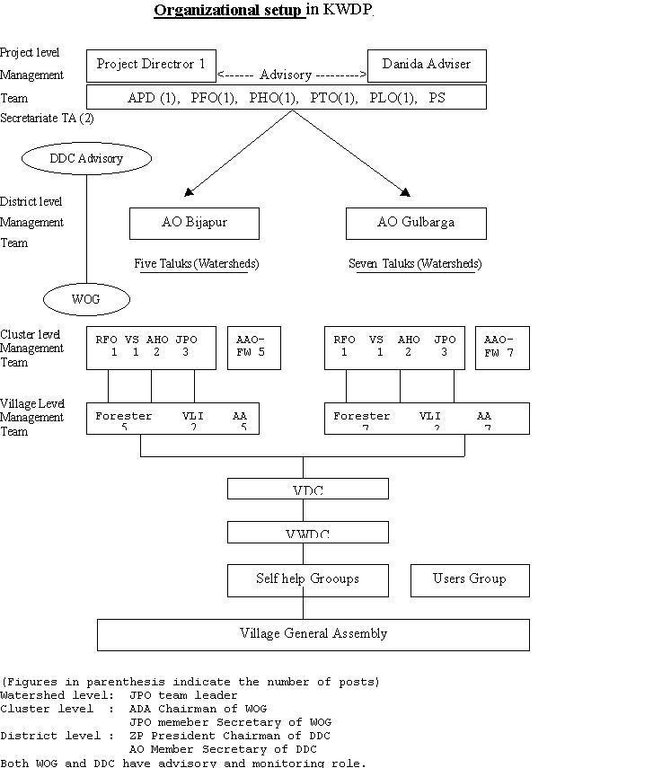Stakeholders participation in the project activities [Índia]
- Criação:
- Atualização:
- Compilador/a: Pranesh Jahagirdar
- Editor: –
- Revisor: Fabian Ottiger
approaches_2373 - Índia
Veja as seções
Expandir tudo Recolher tudo1. Informação geral
1.2 Detalhes do contato das pessoas capacitadas e instituições envolvidas na avaliação e documentação da abordagem
Nome da(s) instituição(ões) que facilitou(ram) a documentação/avaliação da Abordagem (se relevante)
Danida assisted Karnataka Watershed Development Project, Bijapur (Danida assisted Karnataka Watershed Development Project, Bijapur) - Índia1.3 Condições em relação ao uso da informação documentada através de WOCAT
O/a compilador/a e a(s) pessoa(s) capacitada(s) aceitam as condições relativas ao uso de dados documentados através da WOCAT:
Sim
1.4 Referência ao(s) questionário(s) sobre tecnologias da GST

Farm pond [Índia]
A sunken structure (12 x 12 x 3 m, more suiable), constructed by escavation in arable land with a view of temporary runoff storage tapped for protective irrigation, and to increase percolation for recharge of ground water (to convert surface to subsurface flow)
- Compilador/a: Channabasappa Metri
2. Descrição da abordagem de GST
2.1 Descrição curta da abordagem
SWC approach is a participatory methodology to empower the community to plan, implement, monitor, evaluate and manage the SWC technology to bring about sustainability
2.2 Descrição detalhada da abordagem
Descrição detalhada da abordagem:
Aims / objectives: (1) to develop a feeling of ownership, (2) to compare the management of assets created during and after the project in the sustainable manner, (3) to develop capacity amongst the weeker section of the community especially women and resource person, (4) to involve the community at every stage of implementation of the project.
Methods: (1) Participatory Rural Appriasal (PRA), (2) village resourse mapping, (3) training and exposure visits, (4) formation of self help groups, users groups, cattle brreders association, (5) sharing of costs and responsibility (6) partnership with other NGOs, (6) establishment of linkages and networking (7) empowering the coimmnunity throough the livelihood support programs
Stages of implementation: (1) creating awareness, (2) PRA excercises, (3) formation of village level institutions, (4) microplanning, (5) capacity building measures, (6) sharing of cost and responsibilities of management of common property resorses, (7) associating with NGOs and other institutions in rural development (example MANAGE, ICRISAT, University of Agricultural Sciences etc)
Role of stakeholders: (A) participants are of four category (1) project staff (government), (2) members of village level institutions, (3) NGOs and other link organizations and other institutions, (4) international donors (B) Roles :- (1) providing technical support and guidance at every stage of implementation, (2) participation at every stage of implementation, sharing of cost and responsibilities (3) Providing additional technical support (4) providing financial support, guidance, monitoring & evaluation at every stage of implementation.
2.3 Fotos da abordagem
2.5 País/região/locais onde a abordagem foi aplicada
País:
Índia
Região/Estado/Província:
Krnataka state
Map
×2.6 Datas de início e término da abordagem
Indique o ano de início:
1997
Ano de término (caso a abordagem não seja mais aplicada):
2004
2.7 Tipo de abordagem
- Baseado em projeto/programa
2.8 Principais metas/objetivos da abordagem
The Approach focused on SLM only (farm pond, waterharvesting, holistic demonstration)
(1) to develop a feeling of ownership, (2) to compare the management of assets created during and after the project in the sustainable manner, (3) to develop capacity amongst the weeker section of the community, especially women and resource poors, (4) to involve the community at every stage of implementation of the project
The SLM Approach addressed the following problems: (1) The problem addressed include non involvement of the community at different stages of implementation of the project. (2) Lack of empowerment and capacity for the deprived class of the community
2.9 Condição que propiciam ou inibem a implementação de tecnologia/tecnologias aplicada(s) segundo a abordagem
Normas e valores sociais/culturais/religiosos
- Inibitivo
coming together of different community in the village, (2)over exploitation of natural resources
Treatment through the SLM Approach: organizing the village community into different village level institutions based on their ideology and background, (2) creating awareness about the equitable distribution and organized the users groups
Disponibilidade/acesso a recursos e serviços financeiros
- Inibitivo
lack of funds to carry out the activities (2) lack of feeling of ownership
Treatment through the SLM Approach: offered financial support using the cost, benefit and responsibility sharing concept
Quadro institucional
- Inibitivo
lack of village level institutions to take effective implementations
Treatment through the SLM Approach: organised in the village community and establishing an authoritative body to plan, implement the structure
Quadro jurídico (posse de terra, direitos de uso da terra e da água)
- Inibitivo
The existing land ownership, land use rights / water rights moderately hindered the approach implementation The land use rights did not hinder in private land treatments but because of the encroachment of the common land the SWC technology cannot be effectively implemented.
Conhecimento sobre GST, acesso a suporte técnico
- Inibitivo
use of high cost structure for SWC technology
Treatment through the SLM Approach: demonstration of low cost technical structures
3. Participação e papel das partes interessadas envolvidas
3.1 Partes interessadas envolvidas na abordagem e seus papéis
- Usuários de terra/comunidades locais
Village level institutiosn like SHG, UG, CBA, VWDC etc. Specific ethnic groups: Labmani community
Men participation is more in VWDC and CBA while women participation is more in SHGs. the long lasting culture that women remain back and the men lead. The same thing was observed during the initial stages hwever there was considerable change in their understanding and attitude in the following years. Small land holders being part of the VWDC having authority to make decision about the activity to be implemented, they come from different SHGs, who are basically resource poor land users
- Organização não governamental
- Governo nacional (planejadores, responsáveis pelas decisões)
Government of India/ Govt. of Karnataka, Department of Agriculture and watershed development department
- Organização internacional
Danida
3.2 Envolvimento do usuários de terra/comunidades locais nas diferentes fases da abordagem
| Envolvimento do usuários de terra/comunidades locais | Especifique quem estava envolvido e descreva as atividades | |
|---|---|---|
| Iniciação/motivação | Passivo | Mainly:rapid/participatory rural appraisal; partly: interviews/questionnaires; There were the village meeting (gram sabha), group discussions, participatory rural appriasal tools were implemented. |
| Planejamento | Participativo | Mainly: interviews/questionnaires; partly: public meetings; The transect walks with farmers to their individual survey fields during preparation of action plans. |
| Implementação | Apoio externo | Mainly: casual labour; partly: responsibility for major steps; The members of various village level institutions like VWDC used to be present while implementation of CWS activities on common land while those on their individual lands were taken care by respective farmers. Here the cost sharing was t |
| Monitoramento/avaliação | Automobilização | Mainly: measurements/observations; partly: reporting; As and when needed evaluation and status of the structures were taken care by both members and also individually. |
| Research | Nenhum |
3.3 Fluxograma (se disponível)
3.4 Decisão sobre a seleção de tecnologia/tecnologias de GST
Especifique quem decidiu sobre a seleção de tecnologia/tecnologias a serem implementadas:
- Principalmente usuários da terra, apoiados por especialistas em GST
Explique:
the land users want ot implement the activity in consultation with SWC specialists
Decisions on the method of implementing the SLM Technology were made by mainly by land users supported by SLM specialists
4. Suporte técnico, reforço das capacidades e gestão do conhecimento
4.1 Reforço das capacidades/ formação
Foi oferecida formação aos usuários da terra/outras partes interessadas?
Sim
Especifique quem foi capacitado:
- Usuários de terra
- planners
Tipo de formação:
- Agricultor para agricultor
- Áreas de demonstração
- Reuniões públicas
Tipo de formação:
- exposure visits, subject matter trainings
Assuntos abordados:
Regular training were conducted on the subject matter and other technical aspects of various SWC to be implemented in the upper reach, middle reach and in the lower reach etc, for the farmers and other members of VLI, along with the regular other trainings on accounting & book keeping, capacity building etc.
4.2 Serviço de consultoria
Os usuários de terra têm acesso a um serviço de consultoria?
Sim
Especifique se foi oferecido serviço de consultoria:
- Em centros permanentes
Descreva/comentários:
Name of method used for advisory service: group discussion, interaction, exposure visits; Key elements: group discussion, interaction, exposure visits; 1) Advisory service was carried out through: projects own extension structure and agents; Extension staff: mainly government employees 3) Target groups for extension: land users; Activities: subject matter trainings, orientation trainings etc
Advisory service is quite adequate to ensure the continuation of land conservation activities; Since the project staff has complete responsibility of the watershed and since all the staff is government staff, it is adequate for one watershed area.
4.3 Fortalecimento da instituição (desenvolvimento organizacional)
As instituições foram fortalecidas ou estabelecidas através da abordagem?
- Sim, moderadamente
Especifique a que nível (níveis) as instituições foram fortalecidas ou estabelecidas:
- Local
Especifique o tipo de apoio:
- Reforço das capacidades/ formação
4.4 Monitoramento e avaliação
Monitoramento e avaliação são partes da abordagem?
Sim
Comentários:
bio-physical aspects were regular monitored through observations
technical aspects were regular monitored through measurements
socio-cultural aspects were regular monitored through observations
economic / production aspects were regular monitored through measurements
area treated aspects were regular monitored through observations
no. of land users involved aspects were regular monitored through measurements
management of Approach aspects were regular monitored through observations
There were few changes in the Approach as a result of monitoring and evaluation: Like involving the people since day one of the project. First capacity development of the stakeholders and then implementing the activities etc. This would increase the sustainability of the project interventions.
4.5 Pesquisa
A pesquisa foi parte da abordagem?
Sim
Dê mais detalhes e indique quem realizou a pesquisa:
Not applicable
5. Financiamento e apoio material externo
5.1 Orçamento anual para o componente de GST da abordagem
Comentários (p. ex. principais fontes de recursos/principais doadores):
Approach costs were met by the following donors: international (donation by the donor agency DANIDA): 90.0%; local community / land user(s) (cost sharing): 10.0%
5.3 Subsídios para entradas específicas (incluindo mão-de-obra)
- Equipamento
| Especifique quais entradas foram subsidiadas | Em que medida | Especifique os subsídios |
|---|---|---|
| Maquinário | Totalmente financiado | |
- Agrícola
| Especifique quais entradas foram subsidiadas | Em que medida | Especifique os subsídios |
|---|---|---|
| Sementes | Totalmente financiado | |
| Seedlings and biocides | Parcialmente financiado | |
- Infraestrutura
| Especifique quais entradas foram subsidiadas | Em que medida | Especifique os subsídios |
|---|---|---|
| Community infrastructure | Parcialmente financiado | |
5.4 Crédito
Foi concedido crédito segundo a abordagem para atividades de GST?
Não
6. Análise de impactos e declarações finais
6.1 Impactos da abordagem
A abordagem auxiliou os usuários da terra a implementar e manter as tecnologias de GST?
- Não
- Sim, pouco
- Sim, moderadamente
- Sim, significativamente
Improvement in the farm development, orchard, silvi pasture etc., replication of the SWC technology etc.
A abordagem melhorou as questões de posse de terra/diretos do usuário que inibiam a implementação das tecnologias de GST?
- Não
- Sim, pouco
- Sim, moderadamente
- Sim, significativamente
The participatory approach used by the project helped the community to come closure and understand each other problems and work for the village development. The problem is likely to be overcome in the near future.
Did other land users / projects adopt the Approach?
- Não
- Sim, pouco
- Sim, moderadamente
- Sim, significativamente
The other watershed development project in neighbourinng villages undertaken by KAWAD has also initiated the formationof cattle breeders association.
6.3 Atividades de sustentabilidade de abordagem
Os usuários da terra podem manter o que foi implementado através da abordagem (sem apoio externo)?
- Incerto
Caso negativo ou incerto, especifique e comente:
At present due to the continuous support and maintenance of the project staff the lnd users are enthusiastic to use the approach to carry out the acivities but it will be premature to comment at this stage whether they continue to use the approach once no one visits them and make a follow up.
6.4 Pontos fortes/vantagens da abordagem
| Pontos fortes/vantagens/oportunidades na visão do usuário da terra |
|---|
| it has helped them to learn new technology by involving themselves (How to sustain/ enhance this strength: other project/ programs should involve these) |
| they have developed feeling of ownership (How to sustain/ enhance this strength: other projects/ programs should allow them to make decisions) |
| learnt te importance of living in harmony and resolving the conflicts (How to sustain/ enhance this strength: conflict resolution should be top most priority while implementing other projects/ programs) |
| they feel that their capacity and skills are enhanced by organizing the village level institutions. (How to sustain/ enhance this strength: on going support in terms of training and exposure visits should be continued.) |
| Pontos fortes/vantagens/oportunidades na visão do/a compilador/a ou de outra pessoa capacitada |
|---|
| Participatory approaches involves all the staeholders (How to sustain/ enhance this strength: in every other projects or programs the approach whould be continued.) |
| The land users should feel the ownership (How to sustain/ enhance this strength: feeling should be continue even after the withdrwal of the project for 1 or 2 years) |
| there will conntribution from all the stake holders (How to sustain/ enhance this strength: other government project should also develop the procedure of contribution) |
| it is te best tool to introduce the new technology (How to sustain/ enhance this strength: whenever the new technology is introduced all the stakeholders should be involved.) |
| Oppressed class of the people are also involved in the project activities (How to sustain/ enhance this strength: government projects/ programs should develop a system wherein the oppressed class in the community have a say over the decision making) |
6.5 Pontos fracos, desvantagens da tecnologia e formas de superá-los
| Pontos fracos/desvantagens/riscos na visão do usuário da terra | Como eles podem ser superados? |
|---|---|
| treatment of land with one of the forest activities and then SWC measures | more focus on the SWC approach |
| ridge line approach | taking up acivities in the lands which have been leftover during previous years |
| language problem when interacting with the people from the hamlets | better facilitating and involving the educated people of the hamlets while interacting |
| formation of the users group focusig activities after the planting work is over | organising the stakeholders in to UG before undertaking the activities. |
| not much imortance is given to the land users demands during the initial period especially regardnign field bunds | before planting and implementing the activities, landusers demands should be taken into consideration |
| Pontos fracos/vantagens/riscos na visão do/a compilador/a ou de outra pessoa capacitada | Como eles podem ser superados? |
|---|---|
| Low level of literacy | Regular training and capacity building trainings |
| shortage of women staff in the project restricting the interaction with the women land owners | Regular gender sensitization training to the project staff. |
7. Referências e links
7.1 Métodos/fontes de informação
- visitas de campo, pesquisas de campo
- entrevistas com usuários de terras
Links e módulos
Expandir tudo Recolher tudoLinks

Farm pond [Índia]
A sunken structure (12 x 12 x 3 m, more suiable), constructed by escavation in arable land with a view of temporary runoff storage tapped for protective irrigation, and to increase percolation for recharge of ground water (to convert surface to subsurface flow)
- Compilador/a: Channabasappa Metri
Módulos
Não há módulos







